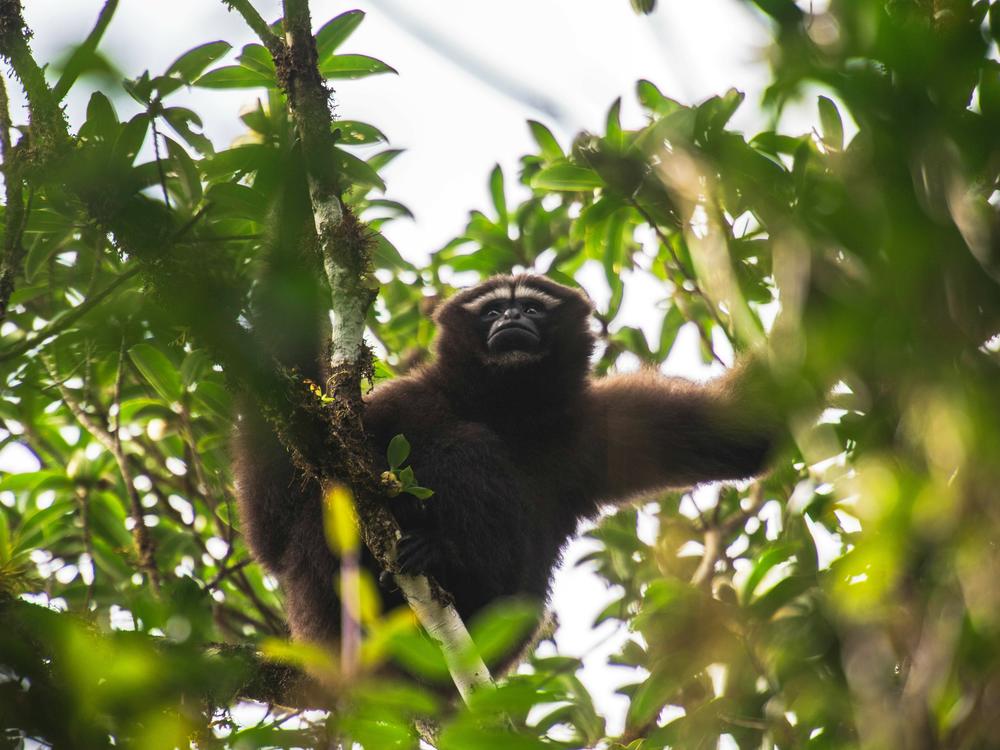Section Branding
Header Content
Didn't get a Valentine's love song? These skywalker gibbons sing love duets
Primary Content
In the green tree canopies of forested areas in Myanmar, you might wake up to the sounds of skywalker gibbons singing love songs. Gibbons start their day with passionate duets. Though these love songs may sound a little different than the ones you've added to playlists, they just helped researchers make a discovery.
Until recently, scientists thought there were fewer than 200 of of these apes – all living in southwestern China. That changed with a new study published in the International Journal of Primatology detailing the existence of a population in neighboring Myanmar.
The Chinese characters for skywalker gibbons' scientific name, Hoolock tianxing, mean "heaven's movement." When scientists discovered the species in China in 2017, they suspected the species' range might extend into Myanmar.
"Chances are if there's continuous forest ... all the way out to a big river that's 100 kilometers away, then we could speculate that gibbons may exist in that 100 kilometers," says Jackie Prime a gibbon researcher at the nonprofit called Prime Earth, who was not part of this study. That's because gibbons do not swim, so she says species tend to be separated by water barriers like rivers.
But Prime says researchers didn't know if skywalker gibbons existed in Myanmar until now because little research has been done on gibbons in general. She says this is in part because they're the fastest tree-dwelling mammals in the world, so they can be difficult to track.
"I like to refer to them as like stealth ninjas when they're moving through the forest," she says. "So they're tiny. They're very quiet."
Quiet except for their duets! Those turned out to be key to their rediscovery.
Researchers set up sound monitoring stations in a variety of forested areas in Myanmar to listen for their songs. Once they confirmed the presence of gibbons, they collected DNA samples using a noninvasive technique created by the study's senior author, Tierra Smiley Evans, a researcher at the University of California, Davis.
The team collected chewed plants and fruits from the gibbons and tested them to ensure they were actually skywalker gibbons rather than a closely-related species. They confirmed the existence of 44 distinct groups – basically family units – of skywalkers in different parts of Myanmar. Smiley Evans says researchers don't know how many individuals there are.
Given that the team doesn't know exactly how many Skywalker gibbons exist and the species is threatened by forest loss and hunting, Smiley Evans says they're suggesting the species maintains its IUCN Red List status as an endangered species. She also says she thinks the study was a success largely because of collaboration efforts with local communities, and that she's optimistic conservation work will continue.
"What was most exciting to me was ... to just be able to see brand new teams becoming absolute experts in this field and excited about continuing this work far beyond this one project. Like, hopefully this is just the tip of the iceberg," she says. "There's a lot more work that needs to be done that will in the future be led by local Myanmar NGOs."
The study was led by the Karen C. Drayer Wildlife Health Center at the University of California, Davis, in collaboration with local researchers and communities in Myanmar.
Want to hear us cover more animal news? Email the show at shortwave@npr.org to let us know!
Listen to Short Wave on Spotify, Apple Podcasts and Google Podcasts.
Listen to every episode of Short Wave sponsor-free and support our work at NPR by signing up for Short Wave+ at plus.npr.org/shortwave.
This episode was produced by Rachel Carlson. It was edited by showrunner Rebecca Ramirez alongside Viet Le and Christopher Intagliata. Stu Rushfield, Kwesi Lee and Maggie Luthar were the audio engineers.

